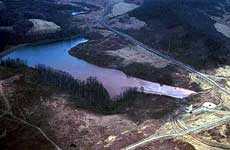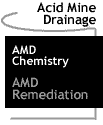
Water
Pollution: Acid Mine Drainage: Remediation
 Remediation
is the process by which something is corrected. The remediation of acid
mine drainage (AMD) refers to the process by which heavy metals are removed
from the AMD-polluted water before it is discharged into a stream. Treatment
of AMD commonly consists of adding strong bases, such as caustic soda
(NaOH, sodium hydroxide), soda ash (Na2CO3, sodium carbonate), or lime
(CaO, calcium oxide; or Ca(OH)2, calcium dihydroxide) to the polluted
water. The bases neutralize the acidity of the AMD. Because they are strong
bases, they ionize and dissolve in water. The resulting hydroxide (OH-)
and carbonate (CO32-) ions combine with hydrogen (H+) ions in the AMD,
taking them out of solution. The products of this reaction are water (H+
+ OH-
Remediation
is the process by which something is corrected. The remediation of acid
mine drainage (AMD) refers to the process by which heavy metals are removed
from the AMD-polluted water before it is discharged into a stream. Treatment
of AMD commonly consists of adding strong bases, such as caustic soda
(NaOH, sodium hydroxide), soda ash (Na2CO3, sodium carbonate), or lime
(CaO, calcium oxide; or Ca(OH)2, calcium dihydroxide) to the polluted
water. The bases neutralize the acidity of the AMD. Because they are strong
bases, they ionize and dissolve in water. The resulting hydroxide (OH-)
and carbonate (CO32-) ions combine with hydrogen (H+) ions in the AMD,
taking them out of solution. The products of this reaction are water (H+
+ OH-
![]() H2O) and carbonic acid (H2CO3). Carbonic acid is relatively
harmless because it is a weak acid. It can be dissociated as water and
carbon dioxide, as described in the bicarbonate
buffering system. Photo:Mine
drainage treatment facility. Photo courtesy of Dr. Ben Stout.
H2O) and carbonic acid (H2CO3). Carbonic acid is relatively
harmless because it is a weak acid. It can be dissociated as water and
carbon dioxide, as described in the bicarbonate
buffering system. Photo:Mine
drainage treatment facility. Photo courtesy of Dr. Ben Stout.
Note the color change in the treatment pond pictured above. The water is red where mine effluent enters the pond. The red color is the iron hydroxide precipitating out of the water. Mechanical aeration (mixing the water) speeds the process by making more oxygen available. (See reactions 1 and 3 in "AMD Chemistry"). The iron hydroxide precipitate eventually settles to the bottom of the pond. This is the area where the red water turns green. The green color is a result of sulfate (SO42-), sodium (Na+), and calcium (Ca2+) ions remaining in the water after acid neutralization reactions occur.
Overview
..|.. Acid
Mine Drainage
..|.. Agriculture
..|.. Sewage
..|.. Dredging
Home
..|..
Teacher Pages
..|..
Modules
& Activities
AMD
Chemistry / AMD Remediation
Glossary .|.
Related Links
.|..
References
..|..
PBL Model
.|
HTML code by Chris Kreger
Maintained by ETE Team
Last updated November 10, 2004
Some images © 2004 www.clipart.com
Privacy Statement and Copyright © 1997-2004 by Wheeling Jesuit University/NASA-supported Classroom of the Future. All rights reserved.
Center for Educational Technologies, Circuit Board/Apple graphic logo, and COTF Classroom of the Future logo are registered trademarks of Wheeling Jesuit University.
